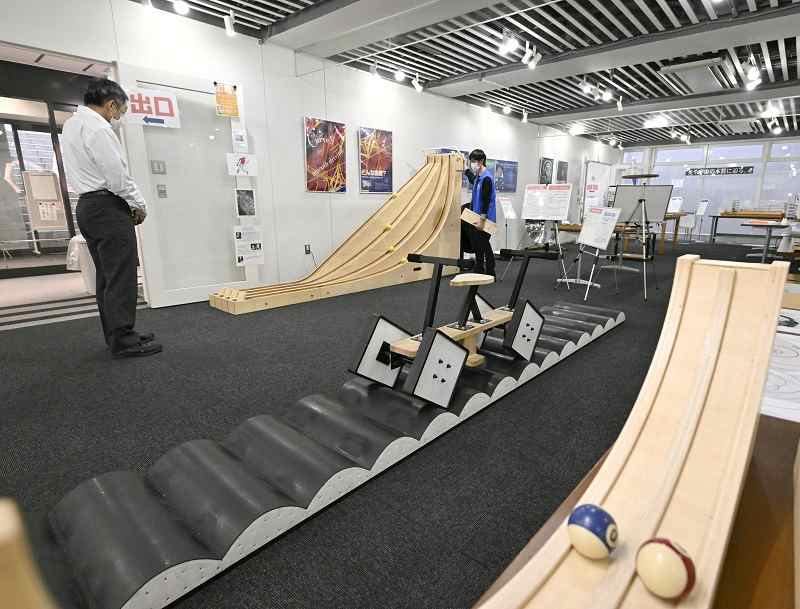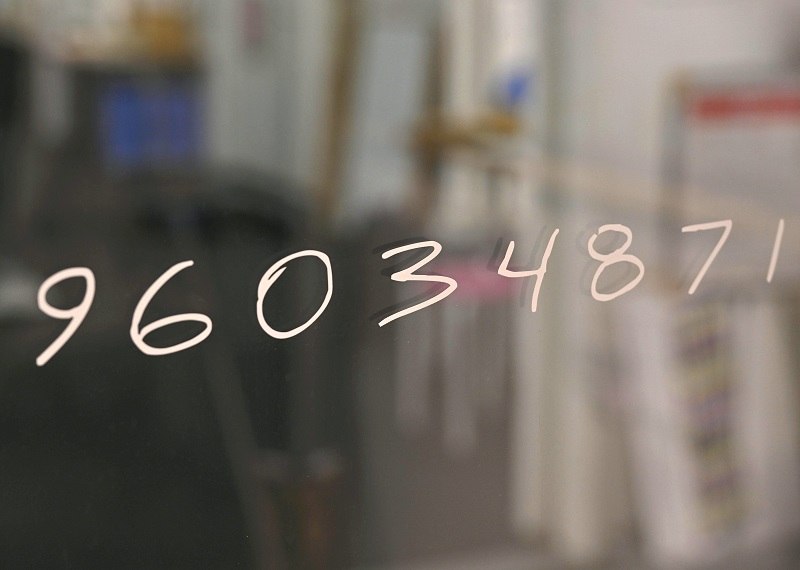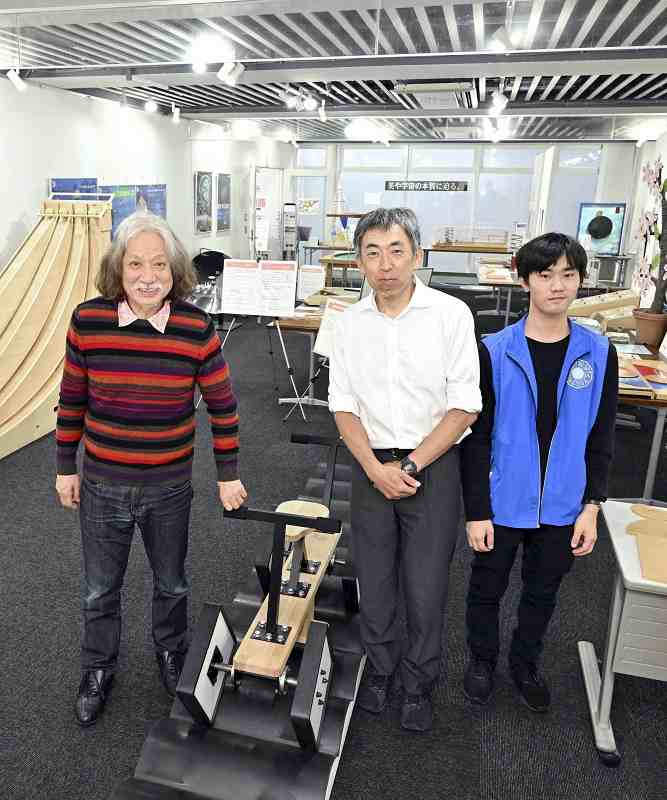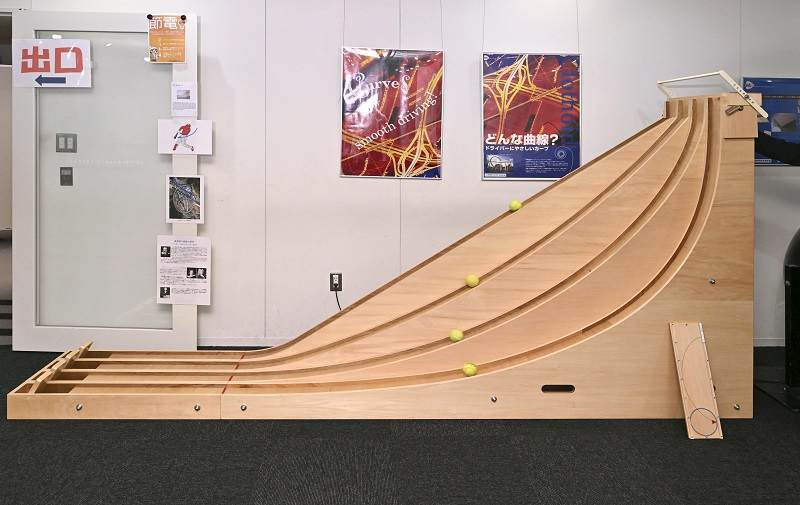
A square-wheeled bicycle that can be ridden smoothly along a special path is displayed at Sugaku Taikenkan (Math Museum) in Shinjuku Ward, Tokyo.
14:21 JST, June 21, 2022
“1529603487152…”

Figures on a glass door at the entrance to the museum
This collection of figures appears on a glass door at the entrance to Sugaku Taikenkan (Math Museum) in Shinjuku Ward, Tokyo, and acts as a number-based welcome to the facility.
Or so I thought.
“They are just there for fun, there’s no particular meaning,” said Yasuyuki Yamaguchi, a 54-year-old staff member at the museum when asked about the figures.
Despite that explanation, I was intrigued and excited, for some mysterious reason, and entered the facility with the sense that I had cracked open a door to a world of mathematics.
Jin Akiyama, 75, a Tokyo University of Science honorary professor, first pitched the idea of opening the museum. As part of his suggestion, he pointed out: “We need a facility where visitors can employ all five senses and actually experience mathematical theories.”

Mathematician Jin Akiyama, left, serves as the facility’s director.
The museum eventually opened in 2013, and the demographics among visitors has a wide range. For example, children come mainly for the experience, and schoolteachers visit to gather ideas to use in their classes.
Visitors can appreciate the charms of the museum, which currently has about 80 items on exhibit.
Handmade wooden experimental learning tools, among others items, lined the inside of the museum, and visitors can gain a sense of its cozy atmosphere.
Museum-goers might feel a little intimidated when observing such challenging phrasing as “sum of squares of Fibonacci numbers” and “optimal stopping problems.”
But the museum’s most distinctive feature is that visitors can gain knowledge on these kinds of difficult mathematical proofs and formulas through experiments.
What quickly grabs the eyes of visitors is an experimental item dubbed “cycloid slide.” It comprises four slopes with both straight and differently curved ramps.

A contraption on which visitors can roll balls to perform a quick experiment on the slopes is seen. The slope second from right is a cycloid curve.
From the same height at the top of the slide, visitors roll balls down the slopes simultaneously and try to guess which of them will reach the goal first, based on the curvature of the incline.
I figured that it would be the ball on the straight slope, but the correct answer was the one on the cycloid curve.
It all comes down to the trajectory drawn on a point on the circumference of a circle when the circle rolls on a straight line. The pattern of this curve is also known as brachistochrone.
Said Yamaguchi: “It is important for people to ponder the reason why their hypotheses are wrong, and to feel something visually and through touching.”
In a corner featuring conic curves, there is a space where mechanisms of parabolic antennas are on display. An antenna of this kind has a single focal point on which lights and radio waves concentrate after they bounce off a paraboloidal surface.
When a table tennis ball is dropped onto the surface of a parabolic antenna, it always bounces back toward the focal point. This natural occurrence is used in various aspects of our daily lives.
Akiyama simply encourages the public to visit the museum. “We want to increase experimental learning tools for advanced mathematics,” he said. “We hope visitors are drawn in because of their curiosity and we then want them to enjoy their experience with mathematics. That’s what I hope to make a starting point for the public.”
Sugaku Taikenkan (Math Museum)
The museum is a facility that is part of Tokyo University of Science. So far, it has welcomed more than 80,000 visitors. Panels and other exhibited items offer easy-to-understand explanations about mathematics. Among the items on display are many learning tools that children can enjoy such as Ghost Leg and metal puzzles.
Address: 1-3 Kagurazaka, Shinjuku Ward, Tokyo
Hours: Noon to 4 p.m. Wednesdays through Fridays and 10 a.m. to 4 p.m. on Saturdays.
Admission: Free. Reservations required.
Related Tags
"Features" POPULAR ARTICLE
-

Sanrio to Open Museum in Yamanashi Pref. Dedicated to Founder, Exhibits Include Hello Kitty, Other Characters
-

Autumn Foliage Surrounds Visitors to Tokyo’s Showa Kinen Park
-

My Daughter No Longer Speaks to Me, But I Want to See Her and My Grandchild
-

Kumamoto: Public Bath Refurbished as Library Where You Can Chat, Take Photos
-

Frozen Vegetables: Demand Rises for Convenient, Tasty Domestic Produce
JN ACCESS RANKING
-

Tokyo Economic Security Forum to Hold Inaugural Meeting Amid Tense Global Environment
-

Keidanren Chairman Yoshinobu Tsutsui Visits Kashiwazaki-Kariwa Nuclear Power Plant; Inspects New Emergency Safety System
-

Imports of Rare Earths from China Facing Delays, May Be Caused by Deterioration of Japan-China Relations
-

University of Tokyo Professor Discusses Japanese Economic Security in Interview Ahead of Forum
-

Japan Pulls out of Vietnam Nuclear Project, Complicating Hanoi’s Power Plans



























